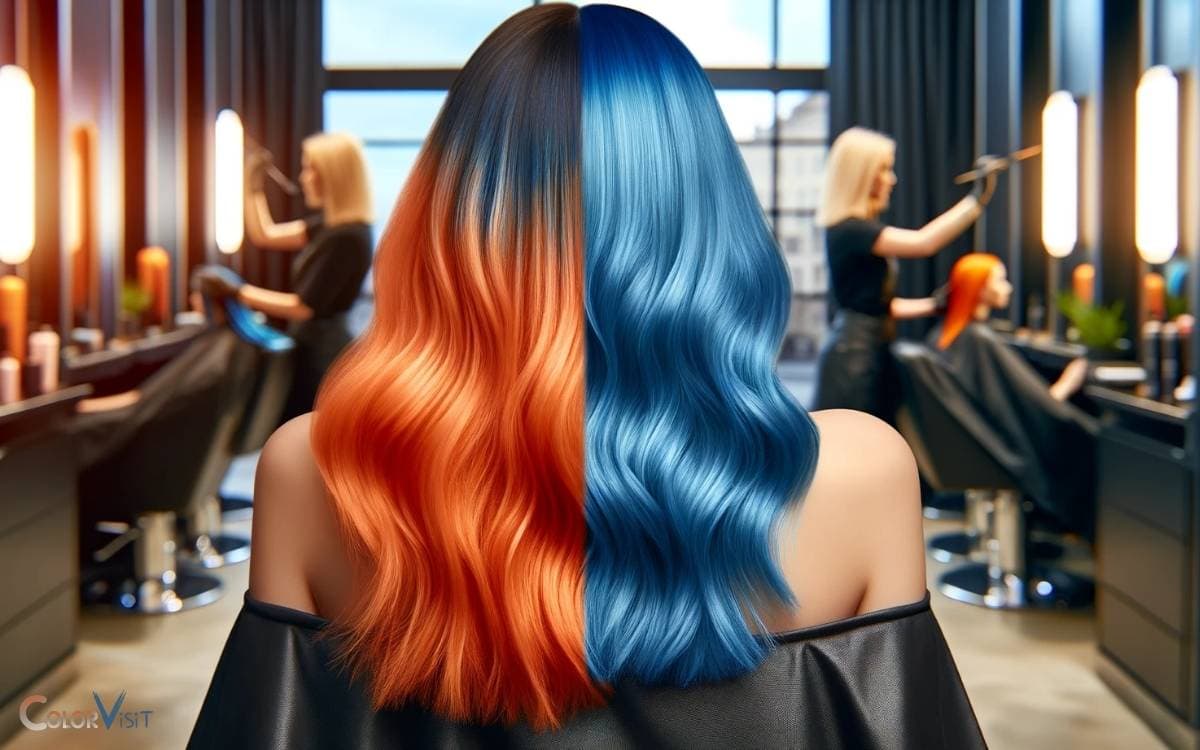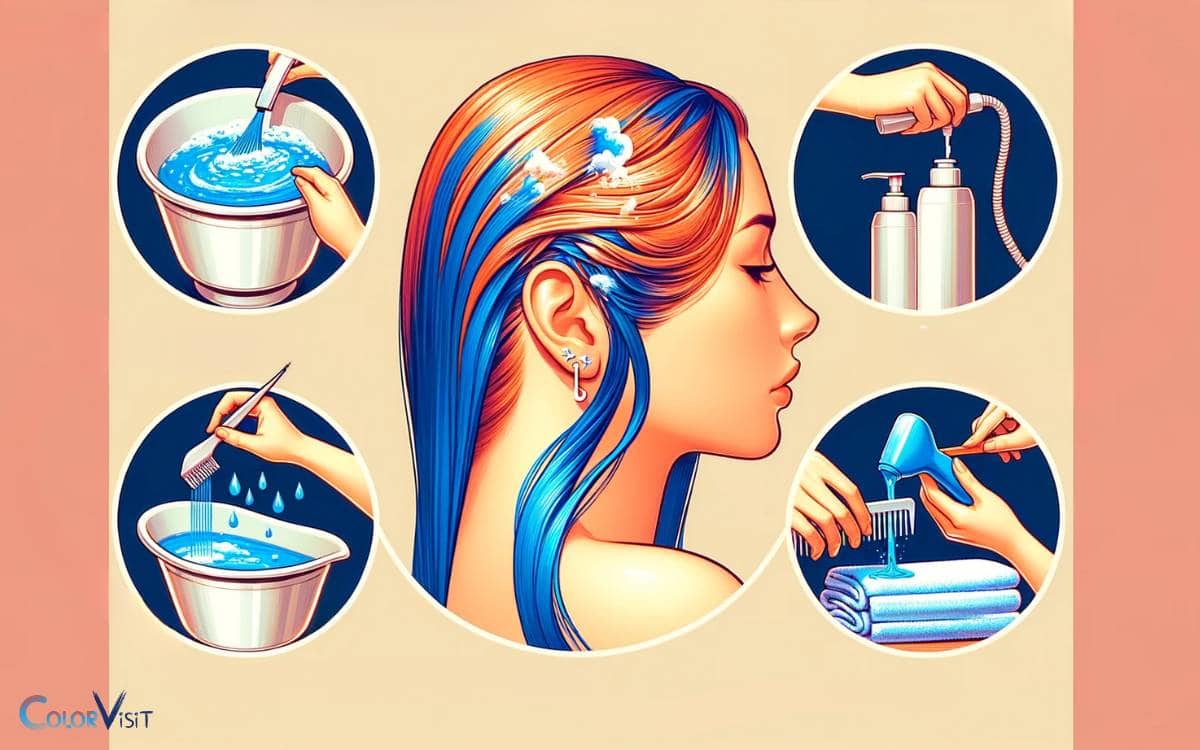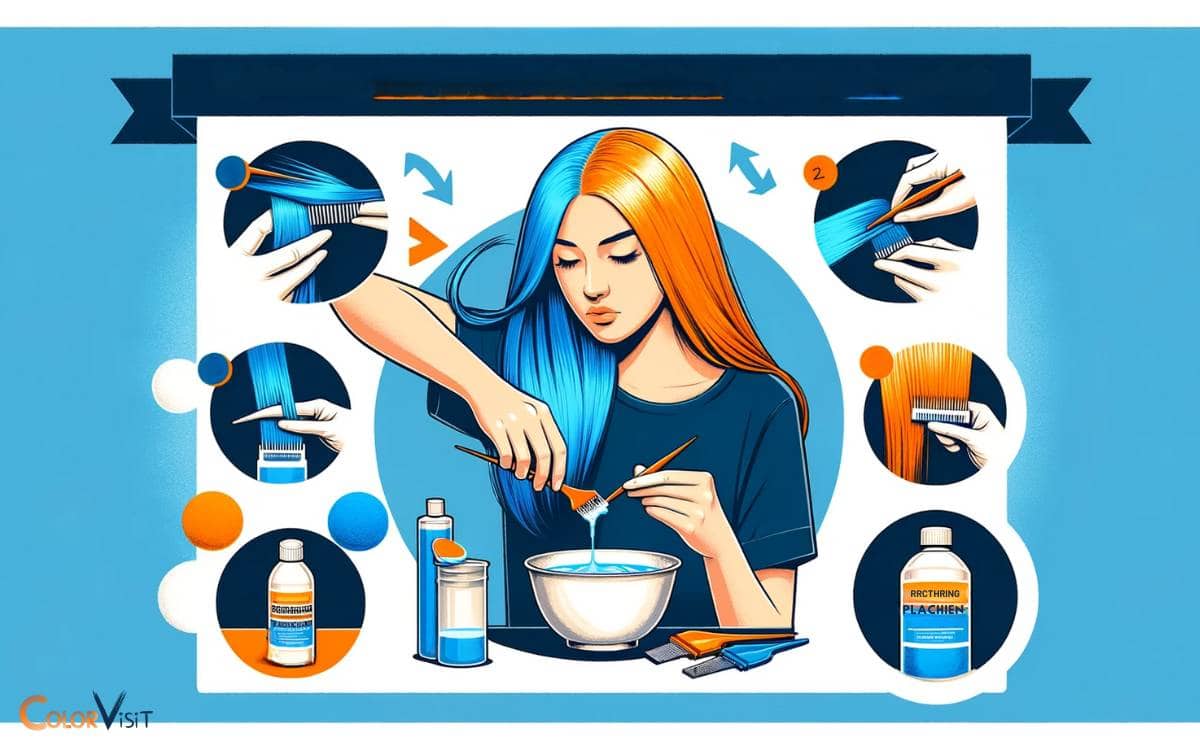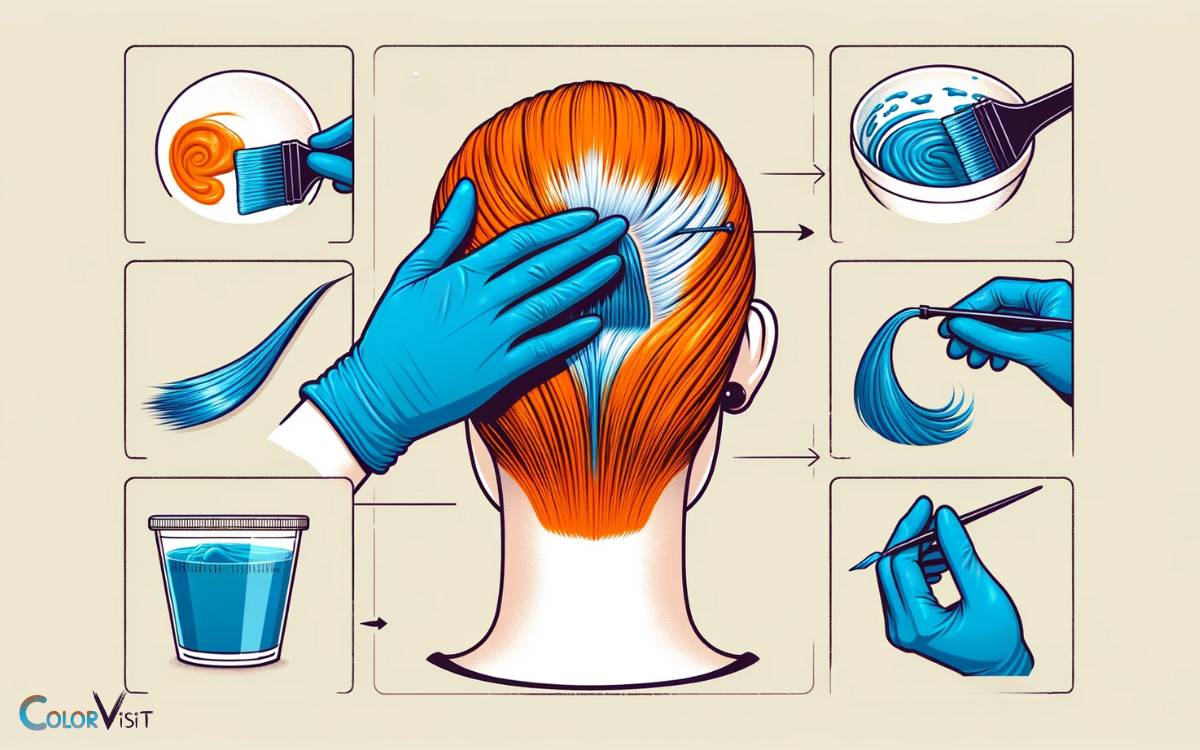Blue Color on Orange Hair: Striking Contrast!
Dyeing orange hair blue is an intricate process that requires a deep understanding of color theory, a meticulous choice of dye, and careful hair preparation to ensure a stunning and lasting transformation.
This guide delves into the necessary steps and considerations for successfully applying blue dye to orange hair, highlighting the importance of choosing the right shade and preparing the hair to achieve an optimal outcome.
Before diving into the dyeing process, it’s crucial to understand how blue and orange pigments interact.
Since orange and blue are complementary colors, applying blue dye over orange hair can result in a rich, vibrant shade if done correctly. However, achieving the perfect balance requires precise knowledge and application.
Steps for Dyeing Orange Hair Blue:
If you’re starting with a light, peachy orange hair color and desire a pastel blue outcome, selecting a light blue dye and using a toner to neutralize any remaining orange before application may yield the best results.
By following these guidelines, you can transform your orange hair into a beautiful blue masterpiece, showcasing the depth and richness of your chosen hue.
Remember, the key to a successful color change lies in understanding the underlying pigment and how it will interact with the new color.
Achieving the perfect blue on orange hair is not just about the dye; it’s an art that blends science, precision, and creativity to unveil a truly unique and eye-catching look.
Key Takeaway
Understanding Color Theory
To fully grasp the impact of applying blue color to orange hair, one must first understand color theory, a fundamental concept that elucidates how colors interact and influence each other.
Within the color wheel, blue and orange are positioned as complementary colors. This relationship is pivotal when considering hair dyeing, as it directly impacts the resulting hue.
Applying blue dye to orange hair necessitates a precise understanding of the underlying pigment interaction.
The blue pigment may neutralize the orange, leading to a cooler tone, or mix imperfectly, resulting in an unintended shade. For innovators in hair coloration, leveraging this knowledge is crucial.
It enables the creation of desired outcomes through strategic application, ensuring that the interaction between these complementary colors produces a harmonious and aesthetically pleasing result.
Preparing Your Hair
Prior to the application of blue dye on orange hair, it is imperative to evaluate the current condition of the hair to ensure it can withstand the chemical processes involved.
Lightening the hair to the appropriate level is crucial for achieving the desired shade of blue, necessitating the use of high-quality bleaching agents.
Selecting the correct products, including the blue dye and any necessary aftercare items, will significantly influence the final outcome and health of the hair post-coloration.
Assessing Hair Condition
Evaluating the health and texture of your hair is a fundamental step before embarking on the process of applying a blue color to orange hair.
This initial assessment is crucial as it determines the hair’s capacity to withstand the chemical processes involved in color transformation.
Professionals recommend conducting a strand test to assess the hair’s porosity, elasticity, and overall strength. This involves applying the color to a small, inconspicuous section of hair and observing the reaction.
A healthy strand will retain its integrity, showing minimal damage and color adherence, indicating readiness for a full application.
Conversely, if the hair exhibits signs of breakage, excessive dryness, or poor color uptake, it necessitates a tailored pre-treatment regimen to restore hair condition, ensuring a successful and even color application.
Lightening Hair Adequately
Understanding the condition of your hair is the first step; the next essential phase involves adequately lightening your hair to prepare it for the vibrant blue color application.
This process necessitates a meticulous approach to ensure the integrity of hair strands while achieving the desired level of decolorization.
The optimal lift should transcend the underlying orange pigment, establishing a neutral or pale yellow base which is imperative for the true blue pigment to manifest vividly.
Employing a professional-grade lightening agent, calibrated with an appropriate developer strength, is paramount.
This precision-driven method minimizes potential damage and prepares the hair cuticle to receive and retain the blue dye, ensuring longevity and saturation of color.
Proper sectioning and application techniques further enhance the lightening efficacy, setting the stage for a successful color transformation.
Choosing Right Products
Selecting the appropriate hair care products is a critical step in ensuring your hair is primed and ready for the application of blue dye, requiring a focus on quality formulations that safeguard hair health while facilitating color absorption.
To achieve optimal results, consider the following:
- Sulfate-Free Shampoo: Choose a gentle, sulfate-free shampoo that cleanses without stripping hair of its natural oils, ensuring the hair maintains its integrity during the color transition.
- Protein-Based Conditioner: Opt for a conditioner rich in proteins to reinforce hair strength, elasticity, and resilience against potential damage from dyeing processes.
- pH-Balancing Toner: Incorporate a pH-balancing toner into your regimen to normalize hair porosity, promoting an even uptake of the blue pigment for a uniform and vibrant color outcome.
Choosing the Right Shade
Choosing the right shade of blue to complement orange hair requires careful consideration of the underlying tones and the desired contrast level.
The selection process involves assessing both the natural and current hues of the orange hair to determine which blue shades will enhance rather than clash.
This decision is pivotal for achieving a harmonious balance that resonates with the individual’s aesthetic preferences and skin tone.
| Blue Shade | Best For |
|---|---|
| Navy Blue | Deep contrast with dark orange tones |
| Sky Blue | Softening bright orange for a subtle transition |
| Electric Blue | Creating a vibrant, high-contrast look |
| Teal | Harmonizing with warm orange to add depth |
Application Techniques
In the process of applying blue color to orange hair, meticulous attention to application techniques is paramount to achieving an optimal outcome.
This entails a thorough pre-application hair preparation, including assessing hair condition and porosity, which significantly influences color uptake and longevity.
Following the selection of an appropriate shade, as previously discussed, the precise method of color application becomes crucial in ensuring even coverage and the desired shade of blue.
Choosing the Right Shade
Determining the optimal shade of blue to apply on orange hair necessitates a thorough understanding of both the underlying color theory and the desired final appearance.
The interplay between the existing orange tones and the blue dye selection is critical to achieving an aesthetically pleasing result.
To aid in this selection process, consider the following:
- Depth of Shade: Lighter blues offer a subtle contrast, ideal for a softer, more nuanced transition, whereas deeper blues create a bold, striking effect.
- Underlying Pigments: Assess the warmth of the orange base to select a complementary blue tone, ensuring harmony and balance in the final color.
- Desired Longevity: Temporary versus permanent dyes influence the vibrancy and maintenance of the blue shade, tailoring the outcome to personal preferences and lifestyle.
Pre-Application Hair Preparation
Before embarking on the transformative journey of applying blue dye to orange hair, it is imperative to engage in meticulous hair preparation to ensure optimal dye adherence and color vibrancy.
| Step | Description |
|---|---|
| Clarifying Wash | Use a clarifying shampoo to remove buildup, ensuring a clean canvas. |
| Hair Assessment | Evaluate hair porosity and health to adjust the dye formula and application process. |
| Strand Test | Conduct a strand test to predict the outcome and adjust the dye mixture if necessary. |
| Moisture Balance | Apply a deep conditioning treatment to fortify hair strands, minimizing damage. |
| Sectioning | Methodically section hair to ensure even application and complete coverage. |
This preparation phase is crucial for achieving a rich, even, and long-lasting color transformation.
Aftercare Tips
To ensure the longevity and vibrancy of blue color on orange hair, it is imperative to adopt a comprehensive aftercare regimen.
This regimen focuses on maintaining the structural integrity of the hair while preserving the brilliance of the blue hue.
Professionals recommend following these critical steps:
- Use Color-Safe Shampoos and Conditioners: Formulations specifically designed for colored hair help prevent the blue pigment from washing out, thus prolonging the vibrancy.
- Apply UV Protection: Direct sunlight can fade the blue color. Using hair products with UV protection guards against this degradation.
- Regular Deep Conditioning Treatments: These treatments are essential for replenishing moisture and nutrients lost during the coloring process, ensuring hair remains healthy and the color, vivid.
Adhering to these guidelines will significantly enhance the color’s durability, allowing individuals to enjoy their vibrant blue on orange hair for an extended period.
Common Challenges
Achieving and maintaining the desired blue hue on orange hair presents several challenges, including color fading, uneven color application, and hair damage. To address these issues, it is essential to use high-quality color treatments and protective hair products. Additionally, opting for shades like crazy color orange for dark hair can create a vibrant base that makes achieving the blue hue more feasible. Regular touch-ups and proper maintenance techniques will also help preserve the color and minimize damage. One effective solution to combat these issues is to use a color oops for vibrant hair, which can help remove unwanted pigments and set the stage for a more uniform blue application. Additionally, it’s crucial to invest in quality hair care products that are specifically designed to protect and enhance color-treated hair, ensuring it remains healthy and vibrant. Regular touch-ups and proper maintenance are also essential for achieving long-lasting results.
The intricate process demands a comprehensive understanding of color theory and meticulous application techniques to mitigate these issues.
Color fading is often expedited by external factors such as sun exposure and frequent washing, necessitating the use of color-protecting products and UV filters.
Uneven color application can result from improper bleach application or varying porosity across the hair shaft, requiring personalized assessment and adjustment of technique.
Additionally, the chemical process can compromise hair integrity, making it imperative to integrate hair strengthening treatments and minimize thermal styling.
Addressing these challenges requires a strategic approach, balancing innovative coloring techniques with rigorous aftercare protocols to achieve and preserve the vibrancy and health of blue-colored hair.
Conclusion
The journey of transforming orange hair to a vibrant blue requires a meticulous understanding of color theory, careful preparation, and the selection of an appropriate shade. It’s essential to choose high-quality dyes to ensure even distribution and lasting results. Additionally, exploring unconventional options like blue food coloring effects on hair can provide a temporary yet bold change. However, one must test a small section first to avoid unwanted surprises.
Application techniques must be precisely executed, followed by diligent aftercare to maintain the integrity and vibrancy of the color.
Like navigating a ship through the tumultuous seas, one must skillfully maneuver through common challenges to ensure the voyage results in a stunning display of azure brilliance.









